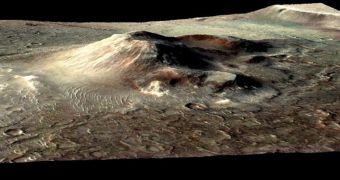A spacecraft orbiting the Red Planet may have discovered the first clear signs of a former hydrothermal environment on Mars. The mounds that indicated the presence of such a habitat were discovered on the slopes of a volcano, and were determined to be some three billion years old.
The reason why this discovery is critically important is that this finding provides the first clear evidence that Earth and Mars may have shared a similar environment shortly after they were formed.
Biologists widely believe that the earliest lifeforms developed on our planet in hydrothermal environments, which provided heat and energy for microorganisms. The fact that this also happened on Mars implies that life had the same chances of developing there as it did here.
These conclusions were recently drawn from analysis of images showing light-colored mounds of silica mineral. The material was found deposited on the slopes of a volcano by the NASA Mars Reconnaissance Orbiter (MRO), which has been surveying the Red Planet since 2006.
According to Brown University expert J.R. Skok, it could be that this location was habitable at the time the volcano was still active. This happened a long time ago, when Mars' core was still active.
“If life did exist there, this would be a promising type of deposit to entomb evidence of it -- a microbial mortuary,” the investigator explains, quoted by Daily Galaxy. He explains that the mounds MRO observed are most likely made up of hydrated silica.
At this point, whether Mars ever featured lifeforms on or beneath its surface is a matter of dispute. What is becoming clear though is the fact that the necessary environment existed in the planet's distant past. Whether organisms took advantage of the opportunity still remains to be determined.
“You have spectacular context for this deposit. It's right on the flank of a volcano. The setting remains essentially the same as it was when the silica was deposited,” Skok says. He explains that the volcano is located near the Martian equatorial region.
“We can read a series of chapters in this history book and know that the cone grew from the last gasp of a giant volcanic system. The cooling and solidification of most of the magma concentrated its silica and water content,” explains Brown University researcher John Mustard.
Interestingly, the hydrated silica mounds at this location look tremendously similar to deposits found around hydrothermal vents on Earth, especially around Iceland.

 14 DAY TRIAL //
14 DAY TRIAL //